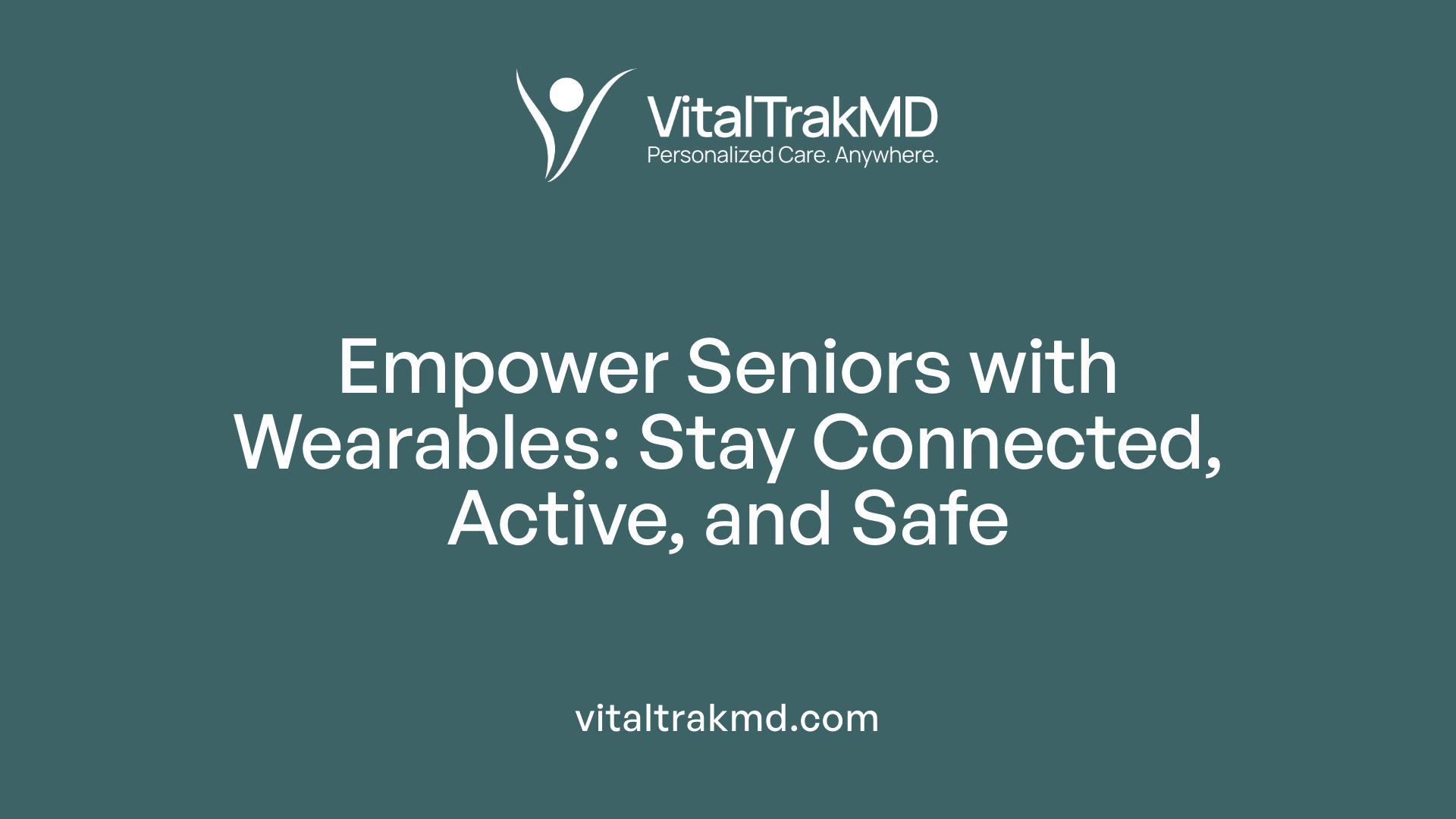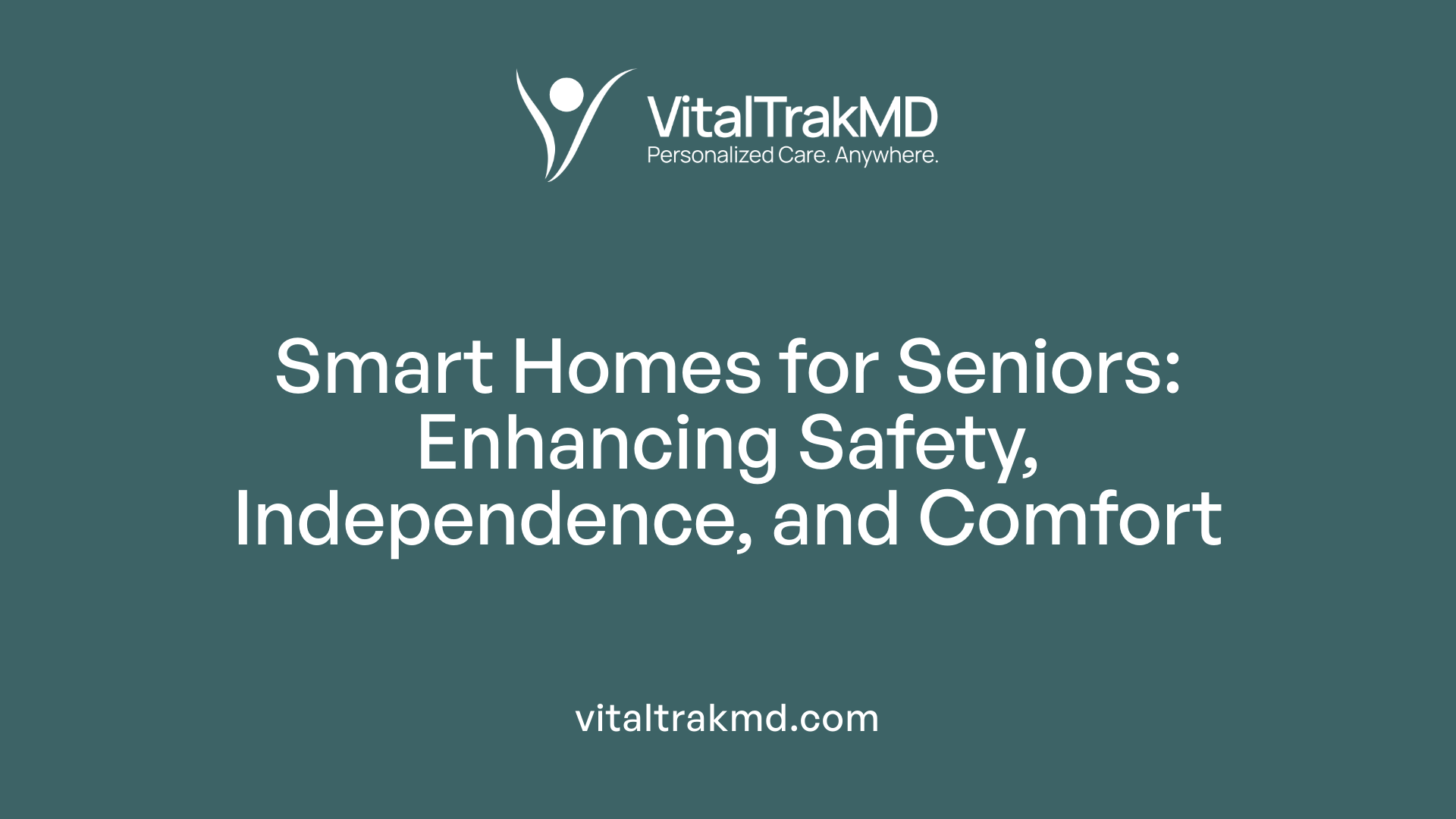Supporting Seniors With Tools for Tracking Health Milestones

Introduction to Senior Health Monitoring
As the senior population grows, maintaining wellness and independence becomes paramount. Advances in wearable health monitors, AI-driven care plans, and smart home technologies equip older adults and their caregivers with vital tools to track health milestones effectively. These innovations not only enhance safety and medical oversight but also promote mental well-being and social connectivity, forming an integrated approach to senior care.
Wearable Technology: Enhancing Independence and Proactive Health Management

Wearable devices for seniors
Wearable technology has become a pivotal tool in supporting seniors' independence and health management. Devices like the Silvertree Reach wristband are specially designed for older adults, offering health and safety monitoring including fall detection, GPS tracking, and emergency notifications. These wearables collect continuous health data, empowering seniors to maintain autonomy while staying connected to their care teams.
Vital sign monitoring
Advanced wearables such as the Apple Watch provide real-time monitoring of vital signs like heart rate and even perform ECGs to detect irregular heartbeats. Other devices track sleep quality, activity levels, and provide insights into overall wellness. This ongoing monitoring enables early detection of health changes, promoting timely interventions before conditions worsen.
Fall detection technology
Falls are a significant health risk for older adults, and many wearable devices incorporate accelerometers, gyroscopes, and AI to detect falls instantly. When a fall is detected, these systems can automatically alert emergency responders or caregivers, ensuring swift assistance and potentially reducing serious injury outcomes.
Emergency response integration
Wearables integrated with emergency response systems allow seniors to summon help easily through voice-activated alerts or automatic notifications sent to family members and medical services. This seamless integration enhances safety and provides peace of mind for both seniors and their loved ones.
Examples of devices
Popular devices such as Silvertree Reach combine multiple features including fall detection, GPS tracking, and emergency notifications tailored for seniors. The Apple Watch offers ECG functionality and irregular heartbeat alerts, while companies like Garmin and Withings provide wearables that monitor sleep, activity, and heart health. These devices not only support medical monitoring but also promote active, healthy lifestyles.
Market growth in wearable health devices
The market for wearable health devices has seen rapid expansion, valued at $13.8 billion in 2020 and projected to reach $37.4 billion by 2028. This growth reflects increasing consumer demand and advances in technology aimed at enhancing health outcomes for seniors and the wider population.
Supporting weight loss goals through wearables
Care programs use wearables to collect longitudinal health data, which informs personalized coaching, dietary recommendations, and physical activity plans. Real-time feedback and activity tracking motivate seniors to adhere to weight loss regimens and improve overall wellness. This personalized, data-driven approach helps individuals stay engaged and effectively reach their health objectives.
Smart Home Technologies: Creating Safer and Supportive Environments

How Do Voice-Activated Assistants Enhance Safety and Independence for Seniors?
Voice-activated assistants like Alexa provide seniors with easy communication and control over their environment without needing to move around. These devices enable residents to make calls, send messages, and control appliances through simple voice commands, effectively reducing loneliness and supporting emergency response.
What Role Do Smart Appliances and Automated Lighting Play in Senior Care?
Smart appliances and automated lighting systems help seniors manage daily tasks safely and conveniently. Automated lighting enhances mobility by reducing fall risks from poor visibility, while smart appliances ensure safe operation, minimizing the dangers of kitchen accidents or other hazards at home.
How Do Safety Devices Support Aging in Place?
Safety devices such as Personal Emergency Response Systems (PERS), GPS trackers, and smart sensors alert care teams and family members to emergencies or unusual activities. These technologies allow seniors to summon help quickly and help prevent wandering, thereby promoting peace of mind for both users and caregivers.
What Are Resident Check-In Platforms and Their Benefits?
Resident check-in platforms monitor seniors' in-home movements and activity patterns, detecting issues like sleep disturbances or wandering early. They offer proactive insights that reduce risks such as falls, facilitating timely interventions to maintain safety and independence.
How Do Smart Home Technologies Facilitate Environmental Control?
Technologies like voice control and home automation empower seniors to adjust temperature, lighting, and appliances easily, allowing them to maintain comfort and autonomy without physical strain. This contributes significantly to preserving independence and enhancing quality of life.
How Are Falls and Wandering Prevented Through Technology?
Advanced sensors combined with AI analyze residents’ movements to detect fall risks or wandering behavior. Fall detection systems using accelerometers, gyroscopes, and AI-powered cameras can provide early warnings or summon help immediately after a fall, substantially reducing related hospitalizations and improving outcomes.
| Technology Type | Functionality | Benefit for Seniors |
|---|---|---|
| Voice-Activated Assistants | Communication, environment control, emergency response | Enhanced safety, reduced loneliness, independence |
| Smart Appliances & Lighting | Automated control of appliances and lighting | Improves safety, reduces accident risks |
| Safety Devices | Emergency alerts, GPS tracking, sensor monitoring | Rapid help access, wandering prevention |
| Resident Check-In Platforms | Monitor activity patterns, detect disturbances | Early intervention, fall and risk reduction |
| Environmental Control | Voice and automated control of home environment | Comfort and autonomy |
| Fall Detection Technology | Sensors and AI to detect falls | Immediate assistance, injury prevention |
Mental Wellness and Social Connectivity as Vital Components of Senior Health

What role does mental wellness play in weight loss and overall health?
Mental wellness significantly impacts seniors’ ability to manage weight and maintain overall health. It influences motivation, emotional regulation, and stress, all critical factors for sustaining healthy behaviors like diet and exercise. When seniors experience strong mental wellness, they are better equipped to handle the challenges of lifestyle changes crucial for weight management.
How do video calling and messaging apps support seniors?
Video calling and messaging platforms enable seniors to maintain social connections with family and friends, which is essential for emotional well-being. These tools help combat isolation and loneliness by providing easy, accessible ways to engage with loved ones and support networks, promoting mental health.
How does virtual reality aid cognitive stimulation?
Virtual reality programs offer seniors engaging experiences that stimulate cognitive functions and provide recreational benefits. By allowing users to explore virtual locations or relive cherished memories, VR helps reduce cognitive decline, boosts mood, and enriches emotional well-being.
What is the role of robotic companions and social engagement tools?
Robotic companions and smart social engagement devices provide practical assistance and emotional support to seniors. They can help decrease feelings of loneliness and promote interaction, fostering a sense of companionship and safety within the home environment.
How do therapeutic digital content platforms contribute to emotional health?
iN2L and Tovertafel are examples of therapeutic digital tools that promote wellness through games, music, travel videos, and social activities. These platforms enhance social participation, cognitive stimulation, and physical activity, especially benefiting seniors with dementia or other cognitive impairments.
How do these technologies address isolation and emotional well-being?
By leveraging tools designed to improve social connectivity and mental engagement, seniors are less likely to experience isolation. This reduced isolation plays a vital role in overall emotional wellness by fostering a more positive outlook and enhancing quality of life. Emphasizing technologies that prioritize mental health equips seniors with the resources needed to maintain balanced emotional states and improve overall health outcomes.
Medication Management and Emergency Response: Ensuring Compliance and Safety

How Do Smart Medication Dispensers and Automatic Locking Pillboxes Help Seniors?
Smart medication dispensers equipped with reminder alerts play a crucial role in helping seniors adhere to their prescribed medication schedules. These devices can notify users when it's time to take their medications, significantly reducing the risk of missed doses. Additionally, pillboxes with automatic locking features prevent accidental double-dosing or mixing of medications by restricting access until the proper time, thereby further enhancing safety.
What Role Do Personal Emergency Response Systems and GPS Tracking Play in Senior Safety?
Personal Emergency Response Systems (PERS) allow seniors to quickly summon help in case of emergencies, often through wearable devices or voice-activated platforms. Combined with GPS tracking, these systems become invaluable for seniors at risk of wandering or losing their way, as caregivers and family members can monitor locations and respond rapidly if an incident occurs.
How Does Voice-Activated Emergency Calling Improve Response?
Voice-activated emergency calling enables seniors to request assistance hands-free, which is especially beneficial during falls or other situations where mobility is limited. This technology ensures that help can be summoned promptly without the need to physically reach emergency buttons or phones.
How Do These Technologies Reduce Risks Associated with Medication Errors and Delayed Emergency Assistance?
By integrating smart reminders, secure medication storage, rapid emergency calling, and precise location tracking, these technologies collectively reduce the chances of medication mistakes and help prevent dangerous delays in emergency response. This comprehensive approach not only supports medication compliance but also enhances overall safety and independence for elderly individuals.
Integrating AI and Predictive Analytics in Senior Care

How is AI used in health monitoring and predictive analytics for seniors?
AI and predictive analytics analyze real-time health data from wearables and other monitoring devices to identify subtle changes and emerging health trends. This enables early detection of potential health issues, allowing care teams to intervene before problems worsen.
How do wearables and EHRs contribute to this integration?
Wearable devices like Apple Watch, Fitbit, and Silvertree Reach collect vital signs, activity, sleep, and heart rhythm information continuously. When synchronized with Electronic Health Records (EHRs), which contain detailed medical histories and medication data, a comprehensive picture of a senior's health is formed. AI algorithms synthesize this combined data to detect anomalies or predict health events.
What is the benefit of shifting from reactive to proactive care?
Traditional healthcare often reacts to symptoms or emergencies. AI-driven predictive tools enable a proactive approach by forecasting potential issues, such as fall risk or declining cognitive function. This system supports timely, tailored interventions that improve outcomes and reduce hospital admissions.
What platforms exemplify these capabilities?
The Artemis Care platform employs camera-based vital monitoring, medication tracking, and safety alerts. Its AI analyzes trends to predict health issues early. Similarly, Care.coach provides continuous health monitoring, medication reminders, and companionship, contributing to significant drops in emergency room visits and falls.
How do these technologies impact emergency visits and hospitalizations?
Studies show that integrating AI-enabled monitoring and support, like Care.coach avatars, can lead to nearly 80% fewer emergency room visits and 50% fewer falls among seniors. The early identification of health risks helps prevent crises requiring hospitalization.
How are interventions personalized based on AI health insights?
AI tailors alerts and care suggestions to individual health patterns and preferences. This personalization ensures interventions are relevant and timely, enhancing seniors' independence, safety, and quality of life.
This integration of AI, wearable devices, and electronic health data is revolutionizing senior care by enabling predictive, personalized, and proactive healthcare delivery that ensures better health outcomes and supports aging safely at home or in specialized facilities.
Holistic Wellness Strategies Supporting Sustainable Weight Loss in Seniors
What are the most effective wellness strategies for sustainable weight loss?
Sustainable weight loss in seniors relies on multiple interconnected wellness approaches.
Balanced diet and physical activity
Emphasizing a balanced diet rich in wholesome nutrients supports healthy weight management. Pairing this with consistent physical activity tailored to the individual's capabilities helps burn calories, improve mobility, and maintain muscle mass.
Monitoring nutrition, sleep, and stress
Regular tracking of nutrition intake, sleep quality, and stress levels is vital. Wearable health monitors and wellness apps allow seniors to collect real-time data on sleep patterns, activity, and stress responses, facilitating early adjustments.
Setting realistic short-term goals
Establishing achievable short-term milestones fosters motivation and measurable progress. These goals can be related to diet, exercise frequency, or wellness check-ins, ensuring seniors stay engaged without feeling overwhelmed.
Behavioral changes and social support
Adopting lasting behavioral changes such as mindful eating and structured exercise routines is enhanced by social connections. Video calling and messaging apps help seniors maintain support networks, reducing isolation and reinforcing positive habits.
Mental wellness integration
Addressing mental and emotional health through mindfulness, virtual reality programs, or wellness content like guided fitness and creative arts promotes resilience and motivation, critical components for sustained weight loss.
Role of technology in supporting these strategies
Advanced technologies such as wearable devices (e.g., smartwatches with biometric sensors), telehealth platforms, and AI-driven wellness tools enable personalized and proactive care. These tools track vital signs, suggest interventions, and provide educational resources, empowering seniors to manage their health effectively.
Integrating these elements creates a comprehensive approach that supports not only physical health but also emotional and social well-being, crucial for sustainable weight loss in older adults.
Stakeholder Perspectives and Data Privacy in Wellness Monitoring
Who are the stakeholders in senior wellness monitoring?
Several groups are involved in wellness monitoring for older adults, each with distinct roles and interests. Older adults themselves are primary users but often see the tools more as resources for healthcare providers rather than for personal use. Healthcare providers value these tools for patient education, tracking health history, and supporting personalized care. Family members, social workers, community organizations, and care facility staff also play varying roles in monitoring, providing support, and managing care information.
What concerns exist about data privacy and control?
Older adults generally prefer to share wellness data with their healthcare providers but have significant concerns about privacy and control over their personal information. Many have difficulties understanding how data sharing mechanisms work and are wary about who can access their sensitive health data.
How does understanding and usability vary among stakeholders?
Older adults often have limited familiarity with self-monitoring technologies, which can hamper effective use. Healthcare providers recognize this and emphasize the need for tools that are user-friendly, while also alerting to varied stakeholder engagement levels and challenges in usability among seniors.
What design considerations improve data sharing and presentation?
Successful wellness platforms use personalized data sharing settings tailored to the user’s role—older adults, family members, or healthcare providers. Empowering users with control over their information and employing multi-layered system approaches allows appropriate complexity and privacy based on stakeholder needs.
How is accessibility balanced with security in health data management?
Designs ensure that wellness tools remain accessible and straightforward for seniors while implementing robust protections for data privacy. This balance supports trust and promotes engagement without compromising sensitive health information, enabling proactive and secure health management for older adults.
Digital Engagement and Wellness Platforms Supporting Emotional and Cognitive Health
Wellness platforms offering expert-led content
Wellness platforms such as Bream provide curated, expert-led digital content aimed at enhancing physical and mental health. These platforms include guided activities in fitness, mindfulness, nutrition, and creative arts, all designed to nurture emotional resilience and maintain cognitive health among seniors.
In-room AI-enabled infotainment
Modern senior living settings are increasingly incorporating AI-enhanced infotainment systems in residents' rooms. These systems analyze content preferences and engagement patterns to gain insights into an individual's cognitive and emotional state. This allows caregivers to tailor personalized interventions that support overall well-being.
Engagement apps monitoring social and cognitive patterns
Engagement applications combined with AI analytics monitor patterns in app usage, shifts in interests, and participation in community activities. This technology provides early detection of social disengagement, cognitive decline, or emerging health concerns, helping caregivers intervene proactively.
Games encouraging physical and mental activity
Interactive games and programs like Tovertafel facilitate social, physical, and cognitive stimulation. These activities not only increase mobility and happiness but also serve therapeutic goals, especially for seniors with dementia or cognitive impairments.
Technology promoting emotional resilience and happiness
Digital tools and platforms contribute significantly to emotional well-being by delivering content that promotes mindfulness, creativity, and social interaction. Together, these technologies support seniors in maintaining a positive emotional outlook and cognitive vitality.
Conclusion: Towards Integrated, Personalized Care for Seniors
The convergence of wearable technology, smart home systems, AI-driven analytics, and digital wellness content is transforming how seniors track and manage their health milestones. By supporting physical, mental, and social well-being through personalized and proactive interventions, these tools empower older adults to maintain independence and improve quality of life. As we advance, addressing usability, privacy, and stakeholder collaboration will be key to maximizing the benefits of health tracking technologies, ultimately fostering sustainable wellness and safer aging in place.
References
- Innovative Technologies Transforming Senior Care & Living
- Perspectives on Wellness Self-Monitoring Tools for Older ...
- Technology Support for Seniors
- Digital Tools Help Seniors Manage Health
- Supporting Senior Living Wellness Through Connected ...
- 16 Examples of Wearable Technology in Healthcare and ...
- The Psychological Side of Weight Loss
Recent articles
Want to Feel Better and Live Healthier?
Join hundreds of patients taking control of their health with personalized care that fits their life – not the other way around.
Rated 4.8/5 by 32+ customers







